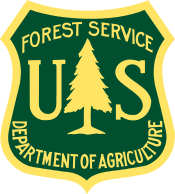Partner Feeds
Terwilliger Fire Update for September 21st (Terwilliger Fire Wildfire)
Smoke Report for Klondike Fire 09/21/18 (Klondike Fire Wildfire)
New trails, new crag access—We’re celebrating National Public Lands Day right
We’re celebrating National Public Lands Day with even more opportunities to get out and discover recreation opportunities with the Washington State Department of Natural Resources (DNR).
On Sept. 22, the Dirty Harry’s Peak Trail and Far Side Climbing Area open, offering increased recreation access in the Middle Fork Snoqualmie Natural Resources Conservation Area (NRCA) east of North Bend and just 45 minutes from Seattle.
The new trail received the majority of its funding from the Natural Areas and Sustainable Recreation capital budgets and are part of an ongoing project to enhance access in the Middle Fork Snoqualmie NRCA.
DNR got started on the project in 2015. Specialists designed and permitted the trail and began looking for stakeholders interested in collaborating to make it happen. A mix of non-profit groups, volunteers, government-led trail crews, and community members rallied behind the project. Then, they got to work.
“Through the collaboration process and working with multiple groups to help complete this project, it was great to see everyone step up and bring their organization’s skillset to the table with enthusiasm,” Sam Jarrett, DNR statewide trails specialist, said. “The vital role these groups played in seeing this project come to fruition is really a testament to how strong and effective our state’s outdoor recreation organizations, volunteers, and agency trail crews can be when working together.”
Three years of collaboration
The first phase of the project was to decommission a significant segment of the old informal Dirty Harry’s Peak hiking route. The route was located on an old forest road where the agency was acting to remove old culverts and other barriers to enhance fish passage and habitat along a South Fork Snoqualmie River tributary.
With the loss of a segment of the old forest road route and an unsanctioned path to the Dirty Harry’s Peak area, DNR decided to repurpose an undesignated hiking and rock climbing access route and collaborated with Washington State Parks to provide developed access from the trailhead it manages at Far Side.
This route, known informally as Birdhouse Trail, was redesigned into a more sustainable location limiting new impacts to the conservation area. This strategy also eliminated the need to create a new trailhead.
DNR worked with the Mountains to Sound Greenway Trust (MTSG) to convert 1.7 miles of upper elevation forest road to trail and decommission remaining forest roads. MTSG developed an additional 0.7 miles of new machine built trail that connects down to the project area boundary tackled by the Washington Trails Association (WTA).
WTA helped lead dozens of volunteer work parties and focused their efforts on a particularly difficult one-mile segment of hand-built trail over steep and rocky terrain. This trail segment required technical trail construction skills to build carefully constructed rock steps and rock retaining walls on an approximately 1-mile segment of challenging trail. WTA contributed more than 12,000 volunteer labor hours to complete this part of the project.
A local DNR trail crew, with support from a Washington Conservation Corps crew, renovated the lower 0.4 miles of trail by repurposing an old forest road grade-to-trail and developing a new trail segment adjacent to the trailhead. These crews also focused their efforts on sign and kiosk installations.
Discover Dirty Harry’s Peak Trail
The years of collaboration and sweat poured into the trail up Dirty Harry’s Peak paid off. DNR is proud to present the new trail with formal access to the Far Side climbing area—though the hike is not to be underestimated.
Dirty Harry’s Peak Trail is a challenging 3.8 mile trail that provides a much-needed hiking addition to the very popular and often overcrowded recreation areas within the Mountains to Sound Greenway corridor, west of Snoqualmie Pass. It begins near the South Fork River valley bottom north of I-90 and ascends to approximately 4,200 feet on elevation.
Dirty Harry’s Peak Trail uses re-routed and renovated segments of a former unsustainable and non-designated trail and is rocky and steep in many sections. It’s perfect for visitors with technical hiking skills and a good level of fitness. It’s not recommended for children or pets because some segments have off-trail exposure to cliff bands and the hike is considered challenging. Hikers are rewarded for their effort with treks through older forest stands that have intermittent views of both the South Fork River valley and surrounding mountains.
To download or print a trail map, click here.
Head out to the Far Side Climbing Area
DNR staff are excited to increase access to more outdoor climbing opportunities near Seattle.
The Far Side Climbing Area has informally existed for years, but this project provided access signs for the trail junctions and maps of the area.
Far Side offers predominately bolted crags ranging in difficulty from 5.6 to 5.12a. There are a handful of trad lines and six multi-pitch options.
The Access Fund and Washington Climbers Coalition were instrumental in providing climbing expertise and helping to bring DNR together with local climbers from the community to provide feedback and to help evaluate an existing network of undesignated trails that served as an informal access to various climbing routes.
“Our partners in the climbing community were really receptive to DNR’s project design goals of developing the minimal trail mileage necessary to provide both the main hiking route to Dirty Harry’s Peak and access to popular climbing area spur trail junctions,” Jarrett said. “We’re reducing the overall associated impacts to the natural area landscape in an effort to provide low-impact recreation.”
The Access Fund and Washington Climber’s Coalition also teamed up to bring trail building resources to the project. The Access Fund-Jeep Conservation Team contributed a mobile pair of professional trail builders that travel across the nation. They oversaw several large volunteer work parties throughout the three-year project development period.
The partnership has resulted in fewer unsanctioned trails and associated impacts, with improved visitor information.
“We worked together to help visitors navigate between hiking and rock climbing pursuits through an improved signage system,” Jarrett said. “We also tried to retain the natural aesthetic of the surrounding environment as much as possible while still providing enough wayfinding information for visitors.”
For a map of the climbing area, click here.
To visit the Far Side Climbing Area’s Mountain Project page, click here.
The public planning process
The DNR Snoqualmie Corridor Recreation Plan was released in March 2015 and included high-priority plans to identify and establish new hiking trail opportunities from the Far Side Trailhead to access the Dirty Harry’s Peak area. It also called for DNR to work with the climbing community to improve rock-climbing access and management in the Interstate 90, Exit 38 area.
The new trail system is a result of the local input and community support that went into that planning effort. Visitors will continue to see improvements identified in the plan on the ground for the next decade.
Conservation efforts in the Middle Fork Snoqualmie River Valley
Middle Fork Snoqualmie Natural Resources Conservation Area, managed by DNR, was established in 2011 and stretches across the forestland east of North Bend to the Mount Baker Snoqualmie National Forest. It protects wildlife habitat, scenic views, and the upper reaches of the rivers. In addition, it provides an approximate 20-mile trail system for low-impact day-use recreation opportunities.
Getting there
Traveling east on Interstate 90, take Exit 38. Follow SE Homestead Valley Road staying briefly on Grouse Ridge Road before tuning into the Far Side Trailhead, which closes each day at dusk. Traveling west on Interstate 90, take Exit 38. Take an immediate right turn on Grouse Ridge Road, after a short drive park at the Far Side Trailhead.
To download or print a trail map, click here.
The Washington State Parks & Recreation Commission owns, manages, and maintains the Far Side Trailhead. DNR collaborated with state parks to improve visitor information at the trailhead kiosk, including new trail system maps to improve the user experience.
A Discover Pass is required to park at the trailhead, get yours here.
Spanish Translation: Klondike Fire Update 2018-09-20 (Klondike Fire Wildfire)
Todays Prescribed Fire Planned Activity (2018 Malheur NF Prescribed Fire Prescribed Fire)
Actualización del incendio – 20-21 de septiembre 2018 (jueves/viernes) (McLeod Fire Wildfire)
Actualización del incendio – 20-21 de septiembre 2018 (jueves/viernes) (Crescent Mountain Fire Wildfire)
September 20, 2018 Klondike Fire Update (Klondike Fire Wildfire)
This Inciweb Site Will be Updated Weekly (Taylor Creek Fire Wildfire)
Miles Fire Update, September 19-20, 2018 (Miles Fire Wildfire)
Bear Camp Road (Forest Road 23) Open: Public Encouraged to Exercise Caution (Taylor Creek Fire Wildfire)
Smoke Report for Klondike Fire 09/20/18 (Klondike Fire Wildfire)
Terwilliger Fire Update for Sept 20th (Terwilliger Fire Wildfire)
09-20 & 21 Update (McLeod Fire Wildfire)
09-20 & 21 Update (Crescent Mountain Fire Wildfire)
2018 9/19-23/18 Natchez Fire Update (Natchez Fire Wildfire)
Re-Opening of Bear Camp Road (Forest Road 23) (Klondike Fire Wildfire)
Burned Area Emergency Response Team Assembled for South Umpqua Comple (Miles Fire BAER Burned Area Emergency Response)
Spanish Translation: Klondike Fire Update 2018-09-19 (Klondike Fire Wildfire)
Blanchard State Forest reaches final phase of collaborative conservation project
After more than a decade of hard work and collaboration between a diverse group of stakeholders, Blanchard Forest has reached a significant milestone.
About 100 people gathered on top of Blanchard Mountain on Sunday despite the chilly rains of early fall along the Salish Sea to celebrate turning the final corner in the Blanchard Forest Strategy, a plan that includes the concept of conserving a 1,600-acre portion of Blanchard Forest.
Washington State Commissioner of Public lands Hilary Franz, never one to have her spirits dampened by the weather, bounded up to Samish Overlook offering hugs and congratulations to the shivering groups of stakeholders gathered atop the mountain to celebrate.
After more than a decade of careful planning and collaboration, the Department of Natural Resources (DNR), its partners and supportive members of the Legislature secured a total of $16.5 million, enough to fully implement the Blanchard Forest Strategy. The money is being used to acquire replacement lands for the core zone so DNR can continue to meet its fiduciary requirements.
“We now have something, through your hard, tireless work, to pass on to our children—and I don’t just mean this unbelievable mountain,” Commissioner Franz said. “I mean the vision that you can maintain this mountain and tell this story.”
The original Blanchard Committee began in 2006 and have spent the past 12 years working on this project. The committee came to the table on behalf of Blanchard and its beneficiaries for years, putting in the work to achieve a unique strategic plan.
In 2008, the committee completed the Blanchard Forest Strategy and the plan, which includes the concept of conserving the core zone, went into action. The committee included interest groups like Conservation Northwest, community members in Skagit County, industrial forest managers, Backcountry Horsemen of Washington, Skagit Land Trust, and Pacific Northwest Trail Association to reach this milestone.
It was a long road, but conservationists, the timber industry, outdoor recreationists, and the county that relies on state timber revenue were united in realizing the vision for Blanchard Mountain.
Washington State Commissioner of Public Lands Hilary Franz addresses a crowd at Samish Overlook during the Sept. 16th Blanchard Celebration. Photo by Sarah DettmerNone of this would have been possible without key supporters in the legislature throwing in their support for the project. Franz said she is grateful for the support of the legislators like Senator David Frockt, Senator Kevin Ranker, Representative Steve Tharinger, and Representative Jeff Morris who fought to get DNR funding to acquire replacement lands.
DNR has already used $4.5 million in legislative appropriations to purchase about 920 acres of nearby forestland from willing private sellers. DNR, in partnership with the Blanchard Committee, is busy purchasing and transferring lands with the remaining $12 million of available funding in order to complete the acquisition of replacement lands for the core zone.
DNR continues to seek additional forest lands to provide timber revenue for Skagit County and other local services, including the Burlington-Edison School District.
As the Commissioner delivered her thanks to the crowd, the rain took a brief pause and the San Juan Islands appeared through the mist beyond the Samish Overlook.
“This area represents what is so amazing about Washington State,” Commissioner Franz said. “You’ve got the mountains, you’ve got the Salish Sea, you’ve got our unbelievable islands, our working forest, and our old-growth forest right here reminding us that we’re some of the most fortunate human beings to be able to live and grace this landscape and call this place home.”
About Blanchard
Blanchard Forest is a 4,800-acre forest in Skagit County managed by DNR. It is located on the southern end of the Chuckanut Range, north of the City of Burlington. The forest is state trust land that DNR manages to generate revenue to support Skagit County public services. A Discover Pass is required to visit the area.
It’s a popular spot for hiking, biking, horseback riding, hang gliding and paragliding. The forest also produces timber that generates revenue for beneficiaries such as Skagit County, the Burlington-Edison School District, Skagit County Road Department, Medic One, the Port of Skagit, and United General Hospital.




